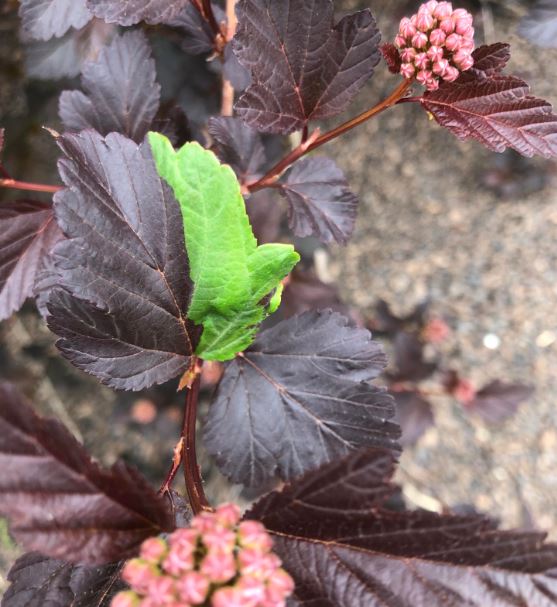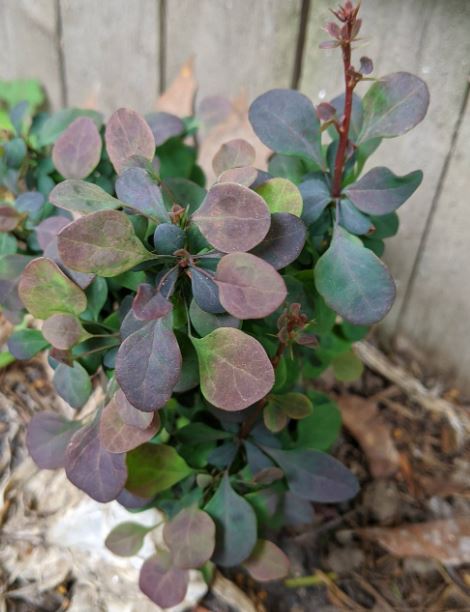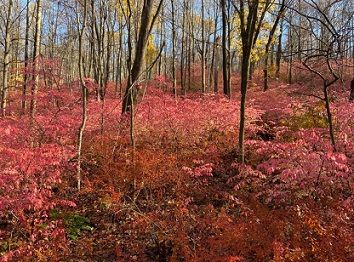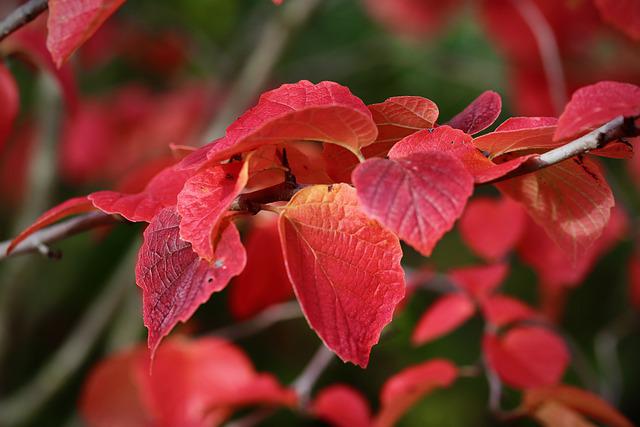Love bushes with color or just can’t handle an entirely green garden? We have great news, red evergreen shrubs produce red foliage as well as every color in-between green and red thorough out the year!
Here are 11 varieties of Red Evergreen Shrubs
- Photinia serratifolia / Photinia serrulata (Oriental/Chinese Photinia)
- Physocarpus opulifolius ‘Monlo’ (Diablo Ninebark)
- Photinia x Fraseri “Canivily” (Christmas Berry)
- Nandina Domestica Obsessed “Seika” (Heavenly Bamboo)
- Cotinus obovatus (American Smokebush/Texas Smoke Tree)
- Pieris floribunda (Forest Flame)
- Leucothoe fontanesiana ‘Zeblid’ Scarletta (Droopy Laurel)
- Abelia x Grandiflora (Sunshine Daydream)
- Euonymus Alatus (Burning Bush)
- Coprosma repens (Mirror Bush)
- Prunus x cistena (Purple Leaf Sand Cherry)
What Are Red Evergreen Shrubs?
What are red evergreen shrubs, and is there even such a plant?
Red evergreen shrubs have red-colored foliage and they do not lose their leaves at any time throughout the year.
They are also shrubs meaning they are woody-stemmed plants that are small to medium-sized.
Red evergreen shrubs differ from your common evergreen shrub as they are more colorful. So, even if they don’t flower they break the tedium of green. The red adds a splash of color to your garden, and it’s possible to have it throughout the year!
Looking to grow Agapanthus? Get the solutions and reasons for white agapanthus leaves before planting.
11 Red Evergreen Shrubs that You Need!
Green gardens have become somewhat boring and people are looking towards bushes with color to spice up their garden. One exemplary option is red evergreen bushes.
Here are 11 evergreen bushes that feature red foliage throughout or at some time of the year.
1) Photinia serratifolia / Photinia serrulata (Oriental/Chinese Photinia)
Also known as Oriental Photinia, this large shrub may start off with reddish foliage but quickly transforms to bronze and finally dark green. This fast-growing shrub reaches a maximum height of 30 feet with an expansive spread of 20 feet!
This photinia is at its best in spring when the new leaves mature to a deep red and then green color. The dense shrubbery can effectively be used to produce a flowering hedge and is known for prolific repeat flowering.
They are growable in USDA zones 7 to 9 in acidic soil ranging from 4.5 to 6.5. Although they don’t stay red, you’ll enjoy the colorful transformation.
2) Physocarpus opulifolius ‘Monlo’ (Diablo Ninebark)

These fast-growing shrubs grow to a height of 8 to 10 feet. They have a textured bark that peels off, to reveal the reddish-brown skin below, like the cinnamon tree. In the fall this tree’s leaves can be Red color with a hint of bronze as well as some purple.
The Diablo Ninebark is not the only type of Ninebark available. Other available ninebarks are
- Little Devil,’ – It has dark leaves.
- ‘Dart’s Gold,’ – It has golden foliage.
- ‘Coppertina,’ Known for its coppery-colored leaves.
The Diablo Ninebark has very attractive pinkish-white flowers appearing in the spring. It should be planted in slightly acidic soil, in well-draining soil. You can grow Diablo Ninebark in USDA hardiness zones 3 to 7.
Check out Hydroponics Setup Costs at Home in the USA – Read here
3) Photinia x Fraseri “Canivily” (Christmas Berry)
Also known as Photinia ‘Canivily’ or simply Christmas Berry, this is a compact shrub that is related to the Red Robin of the same variety.
But it has a deeper red color that persists on the leaf tops. The Canivily is not a fussy shrub and does well in most soils, acidic to neutral, loamy to clay.
The leaves of this shrub emerge as a vivid red color, which matures to dark green color. This ideal shrub produces white flowers in spring, followed by red berries. It is a versatile plant that does well if planted out in the garden or as a hedge.
You can grow this Christmas berry in USDA zones 7 to 9. It is highly invasive in Southern America, particularly Texas!
Note- These shrubs can be toxic to pets and humans. Also, they may let off an odor post-flowering. Hence, many gardeners prefer to prune them off before they open.
4) Nandina Domestica Obsessed “Seika” (Heavenly Bamboo)
It is also known as Heavenly Bamboo or Sacred Bamboo.
This broadleaf is one of the most appealing red evergreen shrubs that can grow up to 2 to 2.5 feet in height. Also, it has the ability to spread up to 1.5 to 2 feet.
The shrub’s name is derived from the fact that it has many slender stems that look like bamboo, so it is aptly named! The Nandina can be grown as an ornamental plant in a container, but does well elsewhere too, particularly as a hedge.
It can grow well in partial shade, however, the red foliage looks electrifying when grown in full sun. The Heavenly Bamboo requires well-draining soil and might need some protection from severe cold.
Once established the Nandina needs a moderate amount of maintenance, making it a popular choice.
You’ll find this shrub blooms from May to June with showy white flowers and can grow it in zones 6 to 9.
5) Cotinus obovatus (American Smokebush/Texas Smoke Tree)

This deciduous bush has purplish-red or green foliage depending on the cultivar. But, during the fall it has a distinct and complete reddish burgundy color. In other seasons foliage appears blue-green.
It grows to a height of between 20 to 30 feet, with a spread of the same range.
These shrubs grow in a variety of soils as long as they are free-draining. It helps that they are drought resistant and can take full sun.
The Smokebush bears small green/yellow/gold flowers which fade and change to fluffy hairs of purplish pink. These little fluffs look like puffs of smoke which is where the shrub got its name from.
They grow in hardiness zones 4 through to 9, so they can be grown in quite a few states in America. Examples of states where this red evergreen shrub grows are:
- Alabama
- Kentucky
- Oklahoma
- Tennessee
- Texas (central)
6) Pieris floribunda (Forest Flame)
It is also known by the name Lily of the Valley Bush or Forest Flame. According to the Missouri Botanical Garden, the leaves are a vibrant red when they emerge. After which they fade to a mild pink then cream, before attaining a shade of green.
The forest flame bears clusters of cream-white colored flowers that stay in bloom from April to May. They can reach a height and width of 4 to 7 feet and look particularly good in a predominantly green garden. The Pieris is grown in zones 5 to 8 as a perennial.
When grown in the Eastern part of the USA, these plants are heavily plagued by numerous pests and diseases.
7) Leucothoe fontanesiana ‘Zeblid’ Scarletta (Droopy Laurel)
Commonly known as droopy laurel because the foliage naturally hangs down and leaves curl inwards like domes. These shrubs take out new immature maroon-colored foliage which matures into a green color. At times with the right amount of sunlight, the leaves appear to have a metallic tinge.
These plants are not particular about their sunlight requirements but must have fertile moist acidic soil. With a height and width of 2 to 3 feet, these plants can spread and need pruning now and again.
The drooping laurel plant should be grown in USDA zones 5 to 8. You can expect multicolored foliage with white flowers in May.
8) Abelia x Grandiflora (Sunshine Daydream)
Also known by the names Abelia, Sunshine Daydream, or a favorite, ‘Abelops’, the ‘Sunshine Daydream’ variant is a relatively new member of the abelia family. This can be a stellar addition with its multi-colored appearance.
The foliage is apricot to red-colored. But, they may show an alternate coloring as well in the form of green and cream.
Throughout the year, the leaves show varied colors making it beautiful on its own. However, there’s another attraction. These plants bear white blooms that are also fragrant.
These full-sun-loving plants grow best in USDA zones 6 to 9. It is obvious that this Abelia variety will do your garden good regardless of timing!
Did you know Abelia x Grandiflora Sunshine Daydream and Agapanthus make for great companions? Here’s where to get Agapanthus plants.
9) Euonymus alatus (Burning Bush)

If you live in Eastern America, you might have heard of the Euonymus alatus or burning bush as it is better known. The reason being this species is invasive to 21 states in the USA.
The neon red colors of this shrub make it a prime candidate for garden landscaping. The burning bush is an ornamental plant drawing its origins from Asia but made its way to the USA.
NOTE- Burning bush will be banned in Delaware from July 2022 due to its highly invasive nature.
What makes the burning bush so invasive is its tolerance to a wide range of conditions. It is grown in shady, full sun, or partially sunny conditions.
10) Coprosma repens (Mirror Bush)
Going by the name Mirror Bush, don’t be misled as this shrub can grow into a small tree as well.
The Mirror Bush differs from most shrubs in the sense that it is dioecious, male and female plants are separate. One particularly interesting cultivar is the ‘Evening Glow’ which is known for displaying colorful variegated leaves.
They transcend from green to orange to a pinkish-red shade of foliage during the autumn and winter season. These shrubs grow to a complete height between 4 and 5 feet and can be used for indoor planting including bonsai.
The Mirror Bush will most likely grow in areas in America with temperatures between 68℉ and 86℉. Below 0℃ (32℉) these plants will drop their leaves and look very bare!
11) Prunus x Cistena (Purple Leaf Sand Cherry)
Many would know this shrub as Purple Leaf Sand Cherry, famous for its deep red, almost plum-colored foliage which blesses this tree throughout the year. It is excellent for breaking what would be a completely green garden.
What’s more, is its pinkish-white flowers which appear in April and effortlessly compliment the red foliage.
These shrubs reach a height of 6 to 10 feet while spreading 5 to 8 feet. Grow this Cherry shrub in USDA zones 2 to 8 for best results.
Conclusion
A red evergreen shrub will add a much-needed contrast to your garden. Whether it’s during the fall or throughout the year, bushes with color make the best ornamental plants for any garden.
They mostly grow in USDA zones 7 to 11 in the USA and prefer high temperatures with moderate to generous watering. Examples of red evergreen shrubs are :
- Oriental/Chinese Photinia
- Diablo Ninebark
- Christmas Berry
- Heavenly Bamboo
- American Smokebush/Texas Smoke Tree
- Forest Flame
- Droopy Laurel
- Abelia x Grandiflora (Sunshine Daydream)
- Burning Bush
- Mirror Bush
- Purple Leaf Sand Cherry
Your garden can get a change of monotonous green with a combination of the above red-foliage shrubs.
Have Dahlias in the garden too? Here’s why Dahlias not blooming, Reasons + Fixes
FAQs
Shrubs that commonly turn red in the fall are cherry shrubs, maple trees, smokebush, birch, and Oakleaf Hydrangea. That’s of course, in addition to the shrubs mentioned in this very blog.
Yes, red evergreens can grow in the USA. Despite originating in other countries many red evergreen shrubs have managed to thrive in North American states.
Do note, in some cases, some of these red foliage shrubs have become invasive species and are banned!

